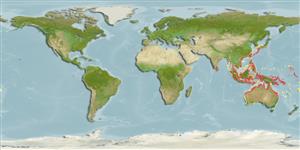Common names from other countries
Environment: milieu / climate zone / depth range / distribution range
Ecología
; salobre. Tropical
Indo-West Pacific: from India to Vanuatu; north to southern islands of Japan, and south to Queensland and New Caledonia.
Length at first maturity / Tamaño / Peso / Age
Maturity: Lm ? range ? - ? cm Max length : 10.5 cm SHL macho / no sexado; (Ref. 348); common length : 7.0 cm SHL macho / no sexado; (Ref. 348)
Widely collected as food in Asia (Ref. 348). Found in intertidal areas in mangrove mud (Ref. 75831, 85174). Also in fresh and brackish waters of mangrove swamps, estuaries, and larger rivers. Highly tolerant to surface desiccation of its habitat; can survive by aerial respiration at the posterior mantle margin for a period of a few days, and feed from subterranean water by means of water exchange through a narrow anterior gape of valves (Ref. 345).
Life cycle and mating behavior
Madurez | Reproducción | Puesta | Huevos | Fecundidad | Larva
Members of the class Bivalvia are mostly gonochoric, some are protandric hermaphrodites. Life cycle: Embryos develop into free-swimming trocophore larvae, succeeded by the bivalve veliger, resembling a miniature clam.
Poutiers, J.M. 1998. (Ref. 348)
IUCN Red List Status (Ref. 130435)
CITES status (Ref. 108899)
Not Evaluated
Not Evaluated
Threat to humans
Harmless
Human uses
| FishSource |
Herramientas
Fuentes de Internet
Estimates based on models
Resiliencia
Alto, población duplicada en un tiempo mínimo inferior a 15 meses (K=0.76).
Vulnerability
Low vulnerability (10 of 100).
Price category
Unknown.
